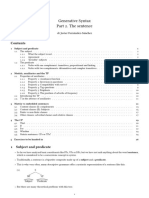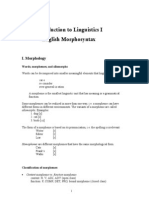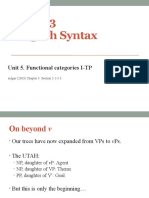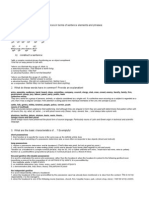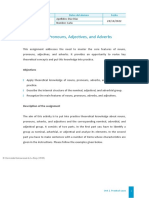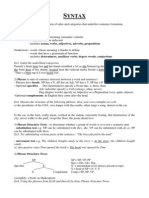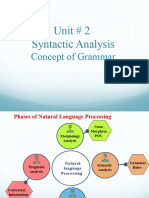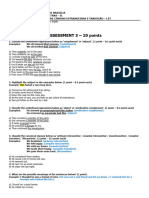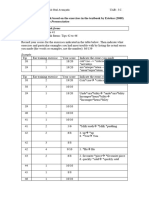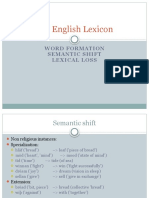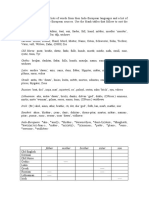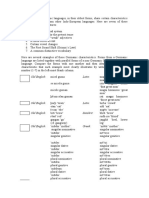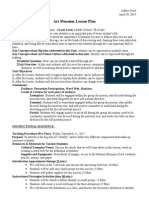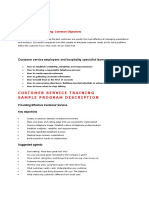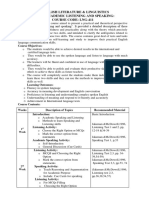English Syntax – Test 1
NAME: NIA:
1. All the following statements are False. Briefly explain why. For statements
1, 3 and 5, provide an example to support your correction.
1. A proposition can only correspond to a single sentence.
A proposition can correspond to more than a single sentence.
E.g. Proposition: ‘John loves Mary’ = ‘Mary is loved by John’
2. Utterances are internal, mental entities defined by the knowledge of a given
language.
Sentences are internal, mental entities defined by the knowledge of a given
language.
Utterances are physical manifestations of sentences.
3. Unacceptable sentences are always ungrammatical.
Unacceptable sentences can be ungrammatical or grammatical.
E.g. Unacceptable but grammatical: #My computer told me a secret yesterday.
E.g. Acceptable but ungrammatical: *This is the man to whom my sister seems to
have sent a letter to.
4. A model with observational adequacy has predictive power and something to
say about grammar.
A model with explanatory adequacy has predictive power and something to say
about grammar.
A model with observational adequacy only lists the grammatical sentences in a
corpus.
5. Children’s deviations from adult grammar are wild and unpredictable.
Children’s deviations from adult grammar are constrained by Universal Grammar
and, hence, correspond to grammars attested in human languages.
E.g. it is possible that children acquiring an SVO language produce patters with
SOV or OVS patterns, which are possible in the languages of the world. (Chidl
Catalan: Sabates posa –OV word order, but OV is not a possible adult word order/
Child English: Car red –N Adj word order, which is not possible in adult English)
1
�2. Read the short extract from Adger (2003) and answer the question below:
The plural feature clearly has an effect not just on the morphology of the word, but
also on its meaning: in this case it affects whether we are talking about one child or
more than one; one man or more than one, and so on. Features that have an effect
on semantic interpretation in this way are called interpretable features. (Adger
2003: 19)
Question: The text refers to one type of feature but there is another type of
feature. Provide a name for it, one example, and briefly explain why this other type
of feature is necessary in the syntactic model that we are developing.
Uninterpretable features
Uninterpretable features are necessary because they are what triggers Merge.
3. Explain how the diagram can be used to describe how speakers generate
linguistic strings.
Lexicon
Syntax
Conceptual-Intensional Articulatory-Perceptual
system system
To generate a linguistic string, speakers select the necessary lexical items from the
Lexicon, a mental dictionary where the words and morphemes we know are
stored, and then combine them by means of syntax (understood as a system of
rules that is mediated by means of morphosyntactic features). The result is then
sent to the interfaces, which interpret the syntactic object for meaning (in the
conceptual-intensional system) and for pronunciation (in the articulatory-
perceptual system).
4. Answer the following questions:
a) What is the difference between privative and binary valued morphosyntactic
features?
Privative features are either present or absent in a word.
Binary-valued features have two values, such as + or -.
b) What is the basic property of the head of a phrase?
The head of a phrase is the element that needs Merge to happen because it is the
lexical item that contains uninterpretable features.
2
�c) What is the difference between Merge and Adjunction?
Merge is a syntactic operation that combines lexical items (or syntactic objects)
triggered by feature-checking. Adjunction is another syntactic operation that is not
triggered by uninterpretable features, it is added to a maximal projection.
d) What is a theta-role? Provide a short definition and a sentence that exemplifies
TWO theta-roles.
A theta-role is a semantic role that arguments of predicates play.
Example: AGENT / THEME
That player kicked the ball very far.
AGENT THEME
5. Use substitution and transposition to show that the PP adjunct in this
example is a constituent. Make sure you identify the PP adjunct.
The writer of that book gave a free copy to the readers on the day of the
presentation
Substitution:
The writer of that book gave a free copy to the readers then
Transposition:
On the day of the presentation, the writer of that book gave a free copy to the
readers
It was on the day of the presentation that the writer of that book gave a free copy
to the readers
6. Choose EITHER the tree in a) OR the tree in b) and add the missing features
and feature-checking processes in the following tree. [In this exercise, the
trees have been analysed as we used to do it before seeing little v, so keep it
that way].
a) VP
NP V [uN]
They
[N] V AdjP
cook
[V, uN, uN] Adj NP
tasty dishes
[N, V, uN] [N]
3
�b) VP
NP V [uN]
He
[N] V NP
cooked pasta
[V, uN, uN] [N]
7. Choose EITHER the tree in a) OR the tree in b) in exercise 6 and find an
instance of Specifier, Complement and head.
a) Specifier: NP They; Complement: NP dishes (of Adj), AdjP tasty dishes (of V);
Head: dishes (both head and XP), they (both head and XP), cook (V), tasty (Adj)
b) Specifier: NP He; Complement: NP pasta; Head: pasta (both head and XP), He
(both head and XP), cooked (V)
8. According to the Extension Condition, where would you have to merge an
Adjunct in the trees in exercise 6?
The Extension Condition says that a syntactic derivation can only be continued by
applying operations to the root projection of the tree. Hence, an Adjunct would
have to be merged with VP in the trees in exercise 6.


